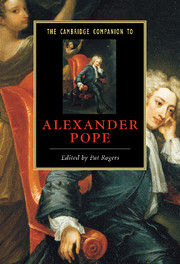Book contents
- Frontmatter
- Introduction
- 1 Pope, self, and world
- 2 Pope’s friends and enemies: fighting with shadows
- 3 Pope’s versification and voice
- 4 Poetic spaces
- 5 Pope’s Homer and his poetic career
- 6 Pope and the classics
- 7 Pope and the Elizabethans
- 8 Pope in Arcadia: pastoral and its dissolution
- 9 Pope and ideology
- 10 Pope and the poetry of opposition
- 11 Crime and punishment
- 12 Landscapes and estates
- 13 Money
- 14 Pope and the book trade
- 15 Pope and gender
- 16 Medicine and the body
- 17 Pope and the other
- Further reading
- Index
12 - Landscapes and estates
Published online by Cambridge University Press: 28 April 2008
- Frontmatter
- Introduction
- 1 Pope, self, and world
- 2 Pope’s friends and enemies: fighting with shadows
- 3 Pope’s versification and voice
- 4 Poetic spaces
- 5 Pope’s Homer and his poetic career
- 6 Pope and the classics
- 7 Pope and the Elizabethans
- 8 Pope in Arcadia: pastoral and its dissolution
- 9 Pope and ideology
- 10 Pope and the poetry of opposition
- 11 Crime and punishment
- 12 Landscapes and estates
- 13 Money
- 14 Pope and the book trade
- 15 Pope and gender
- 16 Medicine and the body
- 17 Pope and the other
- Further reading
- Index
Summary
Pope had a key role in the development and the interpretation of the landscape garden and the country-house estate in the eighteenth century. He has been seen as one of the last Renaissance humanists for whom both the garden and all Nature were speaking pictures, emblems which the humanist used to convey moral meanings. He has been interpreted also as one of the first Romantics, a fundamental influence on the development of the late eighteenth-century picturesque garden. His association with the landed aristocracy led him to co-operate with them in the planning of their demesnes and he made of his own villa and garden at Twickenham, near London, an emblem of his personal principles, horticultural, ethical, and political. His expression of these principles in his writings, when read empathetically, set the highest standards of taste and morality for his society. On the other hand, the whole landscape movement with which he is associated, when read unsympathetically, has been criticized as exploitative and a mystification of power. Seen from this viewpoint, Pope was a lackey of the rich and an apologist for the dark side of British imperialism.
Such diversity of interpretation is indicative of the complexity of the subject and the variation which comes from changing one's viewpoint. The tensions between these readings suggest, perhaps, that there may have been similar tensions (ambiguities, even contradictions) in Pope's personal positions in relation to his society. This is a possibility which will be developed in this essay. It will be claimed, ultimately, that there emerges from these tensions an element of visionary radicalism in Pope's iconology which transcends the limitations of the historical moment.
- Type
- Chapter
- Information
- The Cambridge Companion to Alexander Pope , pp. 161 - 174Publisher: Cambridge University PressPrint publication year: 2007
- 1
- Cited by

